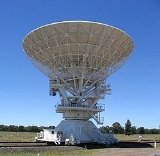
Australia Telescope Compact Array
Encyclopedia
The Australia Telescope Compact Array (ATCA) is a radio telescope
at the Paul Wild Observatory
, twenty five kilometres (16 mi) west of the town of Narrabri
in Australia.
The telescope is an array of six identical 22 metres (72.2 ft) diameter dishes, which commonly operate in aperture synthesis
mode to produce radio
images. Five of the dishes can be moved along a three-kilometre (2 mi) railway track. The sixth antenna is situated three kilometres west of the end of the main track. Each dish weighs about 270 tonnes (265.7 LT).
The compact array is a part of the Australia Telescope National Facility
network of radio telescopes. The array is frequently operated together with the sixty-four-metre (210 ft) dish at the Parkes Observatory
and a single dish at Mopra
(near Coonabarabran
), to form a very long baseline interferometry
array.
Radio telescope
A radio telescope is a form of directional radio antenna used in radio astronomy. The same types of antennas are also used in tracking and collecting data from satellites and space probes...
at the Paul Wild Observatory
Paul Wild Observatory
A number of major astronomical facilities are located at the Paul Wild Observatory near Narrabri, Australia, including:* The Australia Telescope Compact Array radio telescope...
, twenty five kilometres (16 mi) west of the town of Narrabri
Narrabri, New South Wales
Narrabri is a town and seat of Narrabri Shire Council Local Government Area in the North West Slopes, New South Wales, Australia. Narrabri is situated on the Namoi River and lies northwest of Sydney. It sits on the junction of the Kamilaroi Highway and the Newell Highway...
in Australia.
The telescope is an array of six identical 22 metres (72.2 ft) diameter dishes, which commonly operate in aperture synthesis
Aperture synthesis
Aperture synthesis or synthesis imaging is a type of interferometry that mixes signals from a collection of telescopes to produce images having the same angular resolution as an instrument the size of the entire collection...
mode to produce radio
Radio
Radio is the transmission of signals through free space by modulation of electromagnetic waves with frequencies below those of visible light. Electromagnetic radiation travels by means of oscillating electromagnetic fields that pass through the air and the vacuum of space...
images. Five of the dishes can be moved along a three-kilometre (2 mi) railway track. The sixth antenna is situated three kilometres west of the end of the main track. Each dish weighs about 270 tonnes (265.7 LT).
The compact array is a part of the Australia Telescope National Facility
Australia Telescope National Facility
The Commonwealth Scientific and Industrial Research Organisation 's radio astronomy observatories are collectively known as the Australia Telescope National Facility , with the facility supporting Australia's research in radio astronomy....
network of radio telescopes. The array is frequently operated together with the sixty-four-metre (210 ft) dish at the Parkes Observatory
Parkes Observatory
The Parkes Observatory is a radio telescope observatory, 20 kilometres north of the town of Parkes, New South Wales, Australia. It was one of several radio antennas used to receive live, televised images of the Apollo 11 moon landing on 20 July 1969....
and a single dish at Mopra
Mopra Observatory
The 22-metre Mopra Radio Telescope, located near Coonabarabran, New South Wales, is part of the Australia Telescope National Facility, operated by CSIRO. The name hails from the location of the facility close to Mopra Rock a geological formation overlooking the telescope...
(near Coonabarabran
Coonabarabran, New South Wales
Coonabarabran is a town in Warrumbungle Shire in northern New South Wales, Australia. At the 2006 census, the town had a population of 2,609.-History and description:...
), to form a very long baseline interferometry
Very Long Baseline Interferometry
Very Long Baseline Interferometry is a type of astronomical interferometry used in radio astronomy. It allows observations of an object that are made simultaneously by many telescopes to be combined, emulating a telescope with a size equal to the maximum separation between the telescopes.Data...
array.

